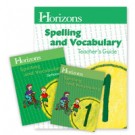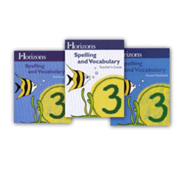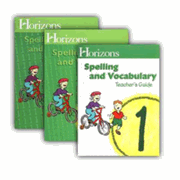Horizons Spelling and Vocabulary series for grades 1 through 3 presents spelling words within groups having common phonograms for the most part, so it provides support for children learning phonics. However, Horizons Spelling and Vocabulary's words have also been selected from the most frequently used words, sight words, and words sharing common rhyming patterns so children learn to spell words they commonly encounter in their reading.
Each course has 160 lessons, providing daily lessons for 32 weeks. First-grade lessons teach 12 basic list words per week and have space for adding two more words of the parent's or teacher's choice. Second grade introduces 17 words: 15 basic words plus two “working words” that are generally commonly-used sight words. Parents or teachers have space to add an additional three words. Third grade teaches 20 words each week: 15 basic words plus five “challenge words” with space to add up to four more words. You might choose to add words that students frequently misspell, words encountered in other subject areas, or words the child wants to use in his or her writing.
Words presented at each level are fairly challenging. While first graders begin with simple words by the end they are expected to spell words such as “rainbow, because,” and “children.” Third graders learn to spell words such as “disagree, discolored, beautiful, yesterday,” and “whistle.”`
There are three essential components for each level: a student workbook, a teacher's guide, and a dictionary. Lessons frequently require teacher presentation from the teacher's guide, so this is not an independent study program. Spelling and phonics rules that apply to the spelling words are only in the teacher's guide. The teacher will usually present them when he or she introduces the week's new words then review them as needed throughout the week.
Each week begins with an assessment of the student's familiarity with the new word list. While the teacher's guide stresses that this is not a pre-test since it is neither scored nor recorded, it functions as many pre-tests do to alert the teacher or parent as to which words a student might already know, which ones are troublesome, and to possibly highlight reversals or letter formation difficulties. After the parent or teacher checks and corrects the student's work, students practice writing words that needed correction. Students next use their words lists to write two sentences using some of their spelling words, and they practice writing all of their words. There are worksheets with a variety of activities for Monday through Thursday in the full-color student book. These activities help students to “examine and explore words,” “look at context and meaning of words,” and “apply understanding of words in writing.” Fridays are for assessment and evaluation, with second and third-grade courses also providing periodic cumulative review. Pages for the assessments, sentence writing, and word list writing are all provided within the student book.
In addition, teacher's guides have one additional, reproducible activity page for each week which can be used as needed. The first-grade teacher's guide also has a section of “Reproducible Phonics Rules Flashcards” that are full-size pages you might copy and post on a bulletin board or give to students for reference.
Teacher's guides provide extended activity suggestions in the lesson plans. Second and third-grade students might also create their own spelling notebooks where they can write sentences for all of their spelling words each week and definitions for any words the teacher or parent might have added to the list. I would caution you to watch the amount of writing required to ensure that it is manageable for each child.
Teacher's guides are printed in black and white and have reduced images of student pages with overprinted answers. Teaching instructions surround the images of the student pages.
The dictionaries for each course are substantial, full-color books ranging from 68 to 120 pages that serve as essential course elements. They feature words with sample sentences for first grade, while second and third-grade dictionaries include pronunciations, identification of the parts of speech, and definitions along with sample sentences. Second and third-grade dictionaries also have cumulative word lists from earlier grades. All books include alphabetized pages for students to write in their supplementary words each week. They also are instructed to look up their spelling words in the dictionary each week which helps them learn how to locate alphabetized words.
The first-grade book presents spelling words only in manuscript printed form. Second grade continues with only manuscript for the first half, then adds cursive forms for the second half of the course; this corresponds to the point where cursive is taught in Horizons' Penmanship program. Third-grade level shows both printed and cursive forms throughout the book.
Christian vocabulary and content shows up from time and some lessons work with Scripture verses, so it is clearly a Christian curriculum.
Overall, Horizons Spelling and Vocabulary offers a traditional approach to spelling with visually-appealing student books. Teaching instruction is easy to follow and requires little to no advance preparation. While some students might find the amount of writing required too demanding, others will find the practice and reinforcement helpful.
You might want to check out the premade lesson plans from Homeschool Planet that are available for Horizons Spelling and Vocabulary.
Find lesson plans available for this product at Homeschool Planet. Sign up for a 30-day FREE trial.











